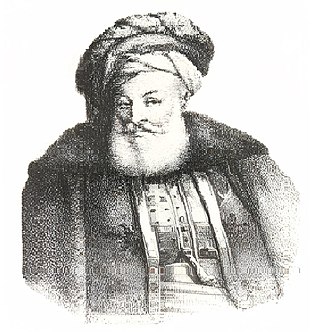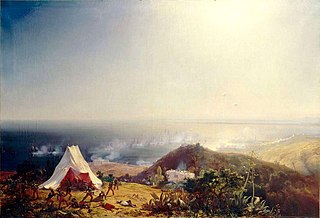
Much of the history of Algeria has taken place on the fertile coastal plain of North Africa, which is often called the Maghreb. North Africa served as a transit region for people moving towards Europe or the Middle East, thus, the region's inhabitants have been influenced by populations from other areas, including the Carthaginians, Romans, and Vandals. The region was conquered by the Muslims in the early 8th century AD, but broke off from the Umayyad Caliphate after the Berber Revolt of 740. During the Ottoman period, Algeria became an important state in the Mediterranean sea which led to many naval conflicts. The last significant events in the country's recent history have been the Algerian War and Algerian Civil War.

Jacques Élisée Reclus was a French geographer, writer and anarchist. He produced his 19-volume masterwork, La Nouvelle Géographie universelle, la terre et les hommes, over a period of nearly 20 years (1875–1894). In 1892 he was awarded the Gold Medal of the Paris Geographical Society for this work, despite having been banished from France because of his political activism.

The Regency of Algiers was a largely independent early modern Ottoman tributary state on the Barbary Coast of North Africa between 1516 and 1830. Founded by the privateer brothers Aruj and Hayreddin Barbarossa, also known as Oruç and Khayr ad-Din, the Regency began as an infamous and formidable pirate base that plundered and waged maritime holy war on European Christian powers. Ottoman regents ruled as heads of a stratocracy; an autonomous military government controlled by the janissary corps, themed Garp ocaklarılit. 'Western Garrison' in Ottoman terminology.

Tuat, or Touat, is a natural region of desert in central Algeria that contains a string of small oases. In the past, the oases were important for caravans crossing the Sahara.

Ahmed Bey ben Mohamed Sherif, also known as Ahmed Bey or Hadj Ahmed Bey was the last bey of Constantine in the Regency of Algiers, ruling from 1826 to 1848. He was the successor of Mohamed Menamenni Bey ben Khan. As head of state, he led the local population in a fierce resistance to the French occupation forces. With the position vacant, in 1833 he adopted the title of leader of Algeria, and dey in exile، although this was not recognized by any other country. In 1837 Constantine was taken by the French after an intense siege. He retreated into the Aurès Mountains from where he continued to wage a low-intensity conflict with tribes still loyal to him, until he capitulated in 1848.

The invasion of Algiers in 1830 was a large-scale military operation by which the Kingdom of France, ruled by Charles X, invaded and conquered the Deylik of Algiers.

The French conquest of Algeria took place between 1830 and 1903. In 1827, an argument between Hussein Dey, the ruler of the Regency of Algiers, and the French consul escalated into a blockade, following which the July Monarchy of France invaded and quickly seized Algiers in 1830, and seized other coastal communities. Amid internal political strife in France, decisions were repeatedly taken to retain control of the territory, and additional military forces were brought in over the following years to quell resistance in the interior of the country.
Anarchism in Algeria mainly concerns the history of the libertarian movement during and after French colonization in Algeria.

Conflicts between the Regency of Algiers and the Cherifian dynasties or Algerian-Sherifian conflicts opposed Morocco to the Ottoman Empire and its dependencies in a series of wars between the Regency of Algiers and its allied local sultanates and tribal confederations, and on the other hand, the Sharifian Saadian and Alawite dynasties that had ruled Morocco since the 16th century.

The Awlad Sidi Shaykh was a confederation of Arab tribes in the west and south of Algeria led by the descendants of the Sufi saint Sidi Shaykh. The Awlad had religious authority, and also owned agricultural settlements and engaged in trade. During the French occupation of Algeria they alternately cooperated with and opposed the colonialists.
The Battle of Chelif or Battle of Djidouia took place on 28 April 1701 on the banks of the Chelif River. It was fought between the armies of the Alaouite Sultan Ismail Ibn Sharif and those of the Regency of Algiers commanded by the Bey of Mascara, Mustapha Bouchelaghem. It took place in the context of an attempt by the Alaouites to conquer the west of the Regency of Algiers, coordinated with an offensive by Tunis on the east of the Regency of Algiers in 1700 and 1701.

The Battle of Moulouya took place in May 1692 at a ford on the Moulouya river in Morocco. It was fought between the armies of the Alawi sultan Moulay Ismail and those of the Dey of Algiers Hadj Chabane.

Baba Ali Chaouch, also known as Ali Soukali, or simply Ali I, was a ruler of the Deylik of Algiers from 1710 to 1718. He was the first dey of Algiers to be invested with the title of dey-pacha. The Sultan Ahmed III had Ali Chaouch's envoy given the caftan and the three tails, a sign of the dignity of a "pasha". This title was attributed to all his successors until 1830.
The Shipwreck of Dellys took place in May 1830, during the French conquest of Algeria. It involved French troupes coloniales, under captains Félix-Ariel d'Assigny (1794-1846) and Armand Joseph Bruat (1796-1855), who were captured by the resistance fighters of the town of Dellys in Kabylia of the Igawawen.
Mustapha Bouchelaghem, also known as Bey Bouchelaghem was the Bey of the Western Beylik from 1686 to 1734/37.

The Tunisian–Algerian war of 1694 was a conflict between the Deylik of Algiers, and the Regency of Tunis.
The Laghouat Expedition were a series of raids led by Morocco, under the reign of Ismail Ibn Sharif from 1708 to 1713.

The Beylik of Titteri was one of the three permanent Beyliks of the Regency of Algiers, the other two being the Western Beylik, and the Beylik of Constantine. It was established in 1546 and was ended during the French conquest of Algeria.
The Tunisian–Algerian War of 1628 was a conflict between the regencies of Algiers and Tunis arising from territorial disputes. The casus belli involved the construction, by the Tunisians, of a military post along the river intended to demarcate the territory between the two regencies.
Hadj Ahmed Chabane Dey was the fourth Dey of Algiers. He ruled from 1688 to 1695, and was the first member of the Algerian Janissary Odjak to ever assume this position. Under his leadership, Algeria enjoyed good relations with France. His military campaigns against Morocco and Tunis were successful. However, his enemies turned his Eastern army against him; he was removed from power and executed.












